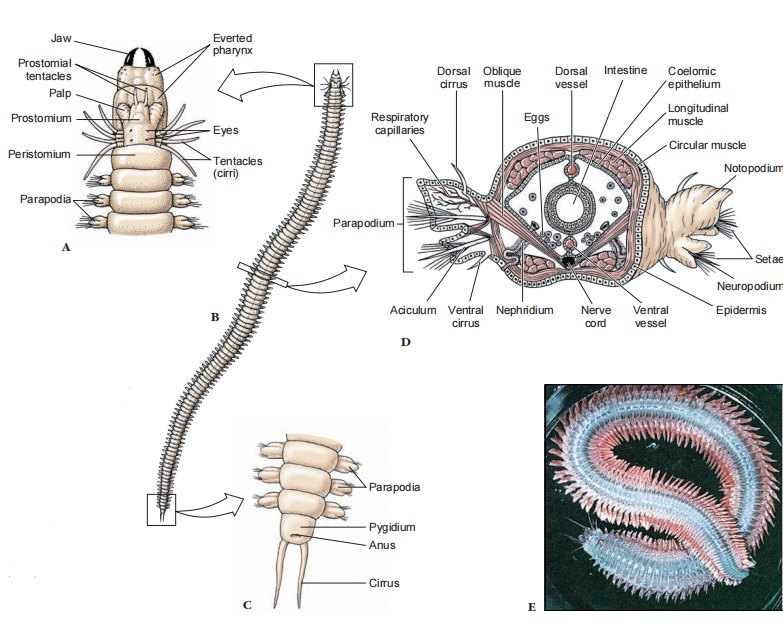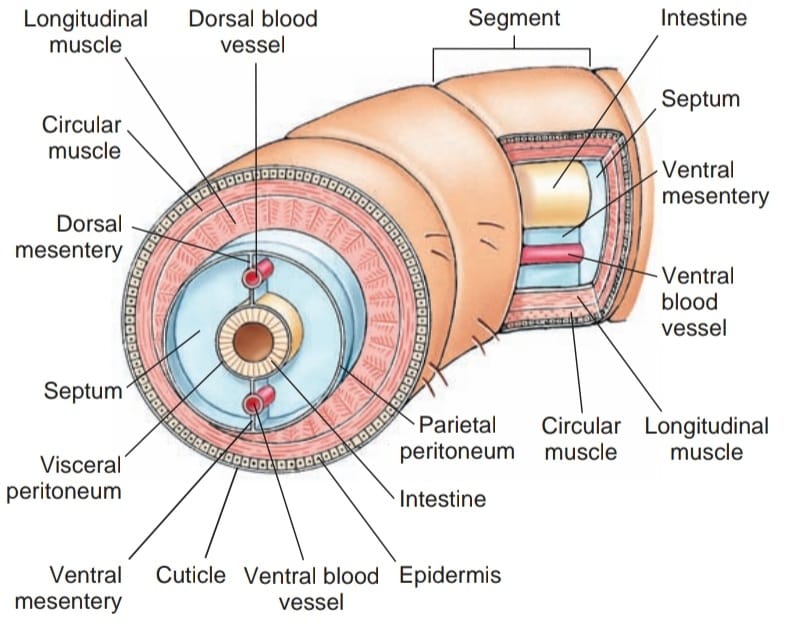Phylum Annelida (an-neli-da) (L. annelus, little ring, ida, pl.suffi x) consists of the segmented worms. It is a diverse phylum, numbering approximately 15,000 species, the most familiar of which are earthworms and freshwater worms (class Oligochaeta) and leeches (class Hirudinida). However, approximately two thirds of the phylum comprises marine worms (class Polychaeta), which are less familiar to most people. Some polychaetes are grotesque in appearance whereas others are graceful and beautiful. They include clamworms, plumed worms, parchment worms, scaleworms, lugworms, and many others.
Annelida are worms whose bodies are divided into similar segments, (also called metameres) arranged in linear series and externally marked by circular rings called annuli (the name of the phylum refers to this characteristic). Body segmentation (metamerism) is a division of the body into a series of segments, each of which contains similar components of all major organ systems. In annelids the segments are delimited internally by septa.
Annelids are sometimes called “bristle worms” because, with the exception of leeches, most annelids bear tiny chitinous bristles called setae (L. seta, hair or bristle). Short needlelike setae help anchor segments during locomotion and long, hairlike setae aid aquatic forms in swimming. Since many annelids burrow or live in secreted tubes, stiff setae also aid in preventing the worm from being pulled out or washed out of its home. Robins knowfrom experience how effective earthworms’ setae are.
Annelids have a worldwide distribution, and a few species are cosmopolitan. Polychaetes are chiefly marine forms. Most are benthic, but some live pelagic lives in the open seas. Oligochaetes and leeches occur predominantly in freshwater or terrestrial soils. Some freshwater species burrow in mud and sand and others among submerged vegetation. Many leeches are predators, specialized for piercing their prey and feeding on blood or soft tissues. A few leeches are marine, but most live in freshwater or in damp regions. Suckers are typically found at both ends ofthe body for attachment to the substratum or to their prey.
The annelid body typically has a two-part head, composed of a prostomium and a peristomium followed by a segmented body and a terminal portion called the pygidium bearing an anus. The head and pygidium are not considered to be segments. New segments differentiate during development just in front of the pygidium; thus the oldest segments are at the anterior end and the youngest segments are at the posterior end. Each segment typically contains circulatory, respiratory, nervous, and excretory structures, as well as a coelom.

External structure. C, Posterior end. D, Generalized transverse section through region of the intestine. E, In this photo of a live N. diversicolor, note the well-defi ned segments,the lobed parapodia, and the prostomium with tentacles.
In most annelids the coelom develops embryonically as a split in the mesoderm on each side of the gut (schizocoel), forming a pair of coelomic compartments in each segment. Peritoneum (a layer of mesodermal epithelium) lines the body wall of each compartment, forming dorsal and ventral mesenteries that cover all organs. Peritonea of adjacent segments meet to form septa, which are perforated by the gut and longitudinal blood vessels. The body wall surrounding the peritoneum and coelom contains strong circular and longitudinal muscles adapted for swimming, crawling, and burrowing.

Except in leeches, the coelom of most annelids is filled with fluid and serves as a hydrostatic skeleton. Because the volume of fluid in a coelomic compartment is essentially constant, contraction of the longitudinal body-wall muscles causes a segment to shorten and to become larger in diameter, whereas contraction of the circular muscles causes it to lengthen and become thinner. The presence of septa means that widening and elongation occur in restricted areas; crawling motions are produced by alternating waves of contraction by longitudinal and circular muscles passing down the body (peristaltic contractions).
Segments in which longitudinal muscles are contracted widen and anchor themselves against the substrate while other segments, in which circular muscles are contracted, elongate and stretch forward. Forces powerful enough for rapid burrowing as well as locomotion can thus be generated. Swimming forms use undulatory rather then peristaltic movements in locomotion.
An annelid body has a thin outer layer of nonchitinous cuticle surrounding the epidermi. Paired epidermal setae are ancestral for annelids, although they have been reduced or lost in some. The annelid digestive system is not segmented: the gut runs the length of the body perforating each septum. Longitudinal dorsal and ventral blood vessels follow the same path, as does the ventral nerve cord.
Traditionally, annelids are divided among three classes: Polychaeta, Oligochaeta, and Hirudinida. Polychaeta is a paraphyletic class because ancestors of oligochaetes and hirudineans (leeches) arose from within polychaetes. Oligochaetes and leeches together form a monophyletic group called Clitellata, characterized by presence of a reproductive structure called a clitellum. Some authorities now consider Clitellata to be an annelid class containing oligochaetes and leeches as orders, but we retain the three classes and consider Clitellata a clade whose members are class Oligochaeta and class Hirudinida. Class Oligochaeta is a paraphyletic group because ancestors of leeches arose from within it.
Useful External Links
- Phylogenomic analyses unravel annelid evolution by Michael Kube
- The Nereididae (Annelida) – diagnoses, descriptions, and a key to the genera by Robin S. Wilson
- Annelida by Greg W Rouse


